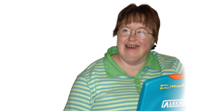Treadmill Training in Cerebral Palsy
| NE-Munroe-Meyer Institute of Genetics & Rehabilitation, UCEDD/LEND | |||
| Program Type | LEND,UCEDD | Fiscal Year | 2011 |
| Contact | Wayne Stuberg, PhD | ||
| [email protected] | |||
| Phone | 402-559-5720 | ||
| Project Description | |||
|
Eleven children with cerebral palsy, age six to 18 years, will participate in a strength training protocol and a body weight support treadmill training (BWSTT) protocol. An AB/BA cross over design will be used to determine which therapy has the largest improvements in the walking abilities, lower extremity strength and participation. Children in Treatment A will participate in the strength training protocol, while children in Treatment B will participate in BWSTT protocol. The respective therapeutic protocols will last six weeks, and will be performed three times a week. There will be an eight-week washout period between the respective treatment interventions. Treatment A will be based on a protocol established by Damiano et al for children with CP, which involves bilateral strength training exercises for the hip, knee and ankle joints. The training will consist of four sets of five repetitions at 65% of the child's maximal isometric strength. The child's strength will be re-measured every two weeks, and the weight lifted will be increased proportionally with the strength gains. The BWSTT will be performed for thirty minutes, and the support levels will range from 10-40% of the child's body weight. The intensity and support levels will be modified as the child improves their endurance. Our goal is not to have the child walk at full weight bearing during the treatment protocol because they are already practicing this during their activities of daily living. Hence, the support levels during the treatment will not be lower than 10% of the child's body weight. We will evaluate each child's walking ability, strength and activity participation before and after they receive the respective treatment interventions. A six-minute walk test and a 10-meter walking speed test will be used to measure changes in the child's walking endurance, and speed respectively. Standard gait analysis techniques will be used to measure changes in ankle power. A hand-held dynamometer will be used to measure changes in the isometric strength of the hip extensors, knee extensors and ankle plantarflexors. Additionally, the Children's Assessment of Participation and Enjoyment (CAPE) self-report survey will be used to measure change in the child's participation in activities outside of school. |
|||







